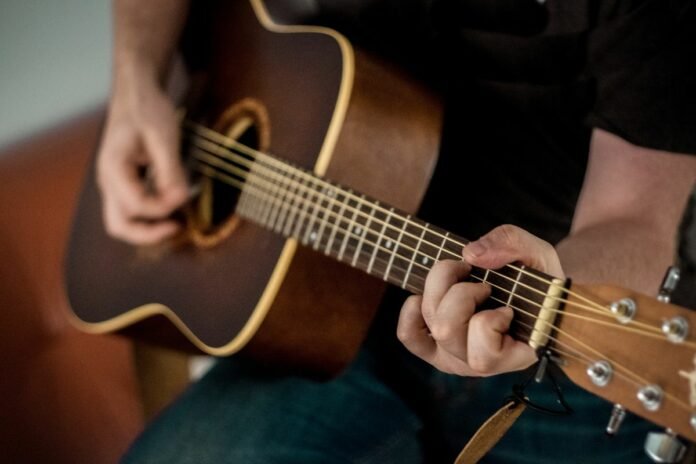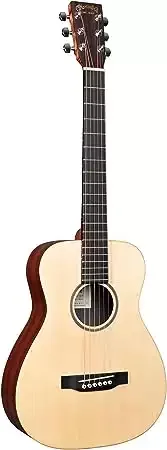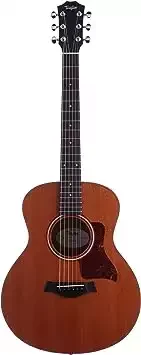Finding the best instrument is not as straightforward as you may think. Yes, a simple web search of “what is the best acoustic guitar?” will come up with answers regarding the most reliable brands and manufacturers.
But, so many factors go into finding the best instrument for you. What is perfect for someone else may not be quite right for you.
The same applies to the acoustic guitar, the instrument that has helped forge some of the greatest pieces of music and songs in history.
After all, Keith Richards of The Rolling Stones is known for saying that you can recognize any good song, simply by stripping back all other instruments and production, and play it on an acoustic guitar with just a voice. If it still sounds good, the song is great.
Of course, it always helps to have a good quality acoustic guitar and these do not come cheap. And, we know that the whole process of finding and buying a new acoustic guitar can be quite daunting and overwhelming, especially for beginners who know little about the instrument.
There are factors upon factors to think about, such as the guitar’s sound quality, its construction, its durability, and playability.
Here at The Guitar Junkie, we understand the importance of taking your time to find the perfect acoustic guitar for you.
It needs to suit your style and, of course, your budget. And, this is applicable to both new guitar players or more experienced guitarists looking for an upgrade.
In today’s post, we are going to help you on your quest to find the best acoustic guitar, whether you’re a newbie or a bona fide rock god.
Along with over twenty years of personal experience, we have gathered knowledge from guitar experts to create this acoustic guitar buying guide.
We will discuss everything there is to consider when buying an acoustic guitar, from the instrument’s body to its size and even the type of wood it is made from.
Let’s find you a new acoustic guitar so you can write and perform your next big hit!
Contents
Why Buy A Good Quality Acoustic Guitar?
If you have started to scour the market for an acoustic guitar, you may have already gotten a little lost. And, don’t worry, this is completely normal!
A quick exploration of the guitar market and you’ll be met with a range of guitar features, price points, and different qualities.
What’s most important is an acoustic guitar that aligns with your budget. Don’t spend thousands of dollars on a guitar only to be in debt afterward. Buy what you can afford.
Beginner guitarists are often put off high-end acoustic guitars because of their price and personal lack of knowledge. Again, sticking to a budget is critical but learning to play on an acoustic that has a great build and boasts excellent features can be highly beneficial.
If you’re a beginner, a quality acoustic guitar is recommended. Firstly, every time you pick up the guitar and start playing it, you will sound better, which will give you more confidence.
This can lead to your guitar skills developing more quickly and your guitar playing experience being more enjoyable. Trust us – learning on a guitar with a fretboard that is uncomfortable to play can quickly put you off playing guitar!
A good quality guitar will also stay in tune so you can practice chords and scales without having to worry about retuning every few minutes.
We know what you might be thinking right now, “but aren’t good quality guitars all expensive?” Well, the good news is that the market is saturated with top quality guitars that have different price points to suit most budgets.
It’s All About How A Guitar Feels
You know that feeling when you meet someone and you just hit it off right away? That’s good chemistry between the both of you. A similar connection is also important when finding a new acoustic guitar.
Any good quality guitar should have basic qualities, including smooth playability, clear tone, and appropriate intonation. But, even when a guitar checks all the correct features, it still may not gel with a person.
Everyone’s preference when playing a guitar is different, meaning their relationship with the instrument will differ compared to another.
Of course, we all want an acoustic guitar that we love the look of. But, you need to use multiple senses when buying a new guitar, not just your eyesight. You need to consider your tactile and sonic senses, too.
Ask most experienced guitarists and they will tell you that they fell in love with a guitar after one strum of the strings. But, this isn’t always the case. Sometimes, you need to revisit the guitar and play it a few more times to “click” with it.
Whether you love it immediately or you friend-zone it first, it’s critical that the guitar you end up buying inspires you somewhat. Do not rush into buying a guitar. Take some time to explore the market and different models of acoustic guitars.
Pay attention to how you feel with it, and you should find the right one sooner rather than later.
An Acoustic Guitar’s Build
It’s important to understand the anatomy of an acoustic guitar, such as its features and even different models. Doing so can help you find better deals and know exactly what you’re looking for instead of going in blind.
A Guitar’s Body
Acoustic guitars differ from electric guitars in that their bodies amplify sound acoustically (hence the name). They work like a sound box so we can hear the vibration of the strings clearly.
You can alter the tension of your guitar strings by tuning them individually until they reach a desired frequency. Generally speaking, most guitarists start with standard tuning – E-A-D-G-B-E. From here, all the basic chords can be learned in their most traditional sense.
When strumming or plucking guitar strings, the energy from their vibrations travels to the top of the guitar, aided by the bridge and saddle. These anchor the strings to the top of the guitar.
The vibration is transmitted along the sides and back of the guitar producing that iconic acoustic sound which is typically projected from the sound hole in the center of the guitar’s body.
When playing a range of acoustic guitars, however, you will notice that one model will sound different to the next. This is because of certain design elements that affect the instrument’s sound.
For instance, the guitar’s body itself can shape the sound transmitted, as well as the type of wood used in construction. Different woods come with different tonal qualities that can greatly affect the sound quality.
There are also the internal components of an acoustic guitar which can control the motion of the top, sides, and back of the instrument. These work in conjunction with the wood and body shape to create the resulting sound of the guitar.
Acoustic Guitar Body Shapes
Narrowing down your acoustic guitar search can be helped by choosing the right body shape. This is because the type of body shape and its dimensions play a key role in how the guitar will sound.
All in all, there are four fundamental guitar sizes:
- Small
- Medium
- Large
- Mini (for children)
Small Acoustic Guitar
Known as Grand Concert (GC) guitars, small acoustic guitars tend to have a well defined, more focused and coherent tone.
These are great when played alongside other instruments as they are generally loud and clear, meaning they are great for those who have a lighter touch on the guitar.
Generally speaking, small acoustic guitars are best suited to those with smaller hands, play mostly finger style, and do not want a very loud guitar.
Medium Acoustic Guitar
Grand Auditorium (GA) acoustic guitars have a medium-sized build. Compared to smaller acoustic guitars, these tend to offer a more dynamic, louder tone, with greater sustain, response, and response to bass.
If you need a more versatile guitar that is well balanced, a medium-sized model is a good place to start. They are ideal for players who are looking for a multi-purpose guitar, or light to medium pluckers. These are also great for beginners.
Another medium-sized guitar body shape is the Grand Symphony (GS). This is slightly larger and louder than a Grand Auditorium guitar but also boasts a dynamic tonal range, powerful sound, and robust bass response.
This type of guitar is popular amongst acoustic rock performers, those who play dynamically, and with strong strumming or picking styles.
The Dreadnought (DN) is another medium-sized acoustic guitar which offers clean, clear treble notes, a strong sound, a higher midrange, and low-end power.
Players who are looking for a more vintage sound love these guitars. They are also ideal for flat pickers and those who strum most of their songs.
Large Acoustic Guitar
Now, onto the beasts of the acoustic guitar world! One body shape is the Grand Orchestra (GO). This type of acoustic guitar has a powerful sustain and dynamic range with a multifaceted, string voice.
Thanks to its large body, it is very responsive and well-balanced. Guitarists who prefer increased density and play with a dynamic style are best-suited to these large guitars.
Mini Acoustic Guitar
These are the smallest of all acoustic guitar sizes. However, they still offer a full-voice thanks to how they are designed and their structure. If you regularly travel, a mini guitar is the answer as they are the most portable of all sizes.
They are also ideal for children and those with smaller hands. And, if you simply want to strum the guitar on occasion at home, these tend to be more affordable compared to those designed for regular playing and performances.
Cutaway Or Non-Cutaway Acoustic Guitars? That Is The Question
You will notice that some acoustic guitars are made with a cutaway. This is located on the upper bout of the guitar body adjacent to the guitar neck.
This cutaway allows players to gain better access to the frets that are closest to the sound hole. It also improves the playing range of the guitar.
One query many have is whether a cutaway affects a guitar’s tonal quality. Generally speaking, no, it does not.
Yes, the cutaway does reduce the surface area of a guitar’s soundboard, as well as the interior’s air cavity, but where the cutaway is located does not receive much vibration.
Therefore, its tonal quality is not affected by this portion of the guitar. Instead, it is mostly affected by the thinner region of the guitar’s waist.
So, is an acoustic guitar with a cutaway better than one without? This depends on what style you like the look of most.
If the aesthetic appearance of your guitar is of main priority, then a non-cutaway model may be best. On the other hand, if you want to reach those high notes, you will need a cutaway acoustic.
Solid Top Or Laminate Top Guitars?
Most acoustic guitar tops are either made with solid wood or laminate. A solid top is typically constructed with two pieces of singly-ply wood. The grains of these are typically matched to the guitar top.
On the other hand, laminate guitar tops are made from different layers of wood. The bottom consists of multiple layers whilst the upper layers consist of higher-quality pieces of wood all of which are flattened together.
The type of top material can also determine the guitar’s sound. For instance, solid wood vibrates more efficiently than laminate tops. Because of this, laminate tops do not produce as rich a tone or as powerful a volume and solid wood.
Laminate tops are also generally cheaper making them good options for beginners who may not have a large budget or do not want to spend much on their first guitar.
Strings – Nylon Vs Steel
If you’re new to acoustic guitars, you’re probably wondering what the difference is between nylon and steel strings or if there are any differences. Aside from the material these strings are made out of, their tones and how they feel when playing also differ.
Steel strings provide greater string tension, producing louder, brighter sounds. They also create increased tonal sustain when either plucked or strummed.
Acoustic guitars with nylon strings tend to have lower string tension, producing less sustain with a softer sound. Classical guitars generally have nylon strings, whilst those used by rock performers are mostly steel stringed. But, this is not a set rule.
If you’re a beginner, a nylon string guitar is ideal. This is because the strings are typically easier to press down, therefore not putting as much strain on the fingers and leaving those indentations that are painful for new guitar players.
But, it’s not just the string material that should be considered. A great deal of nylon string acoustic guitars have wider necks resulting in a more challenging playing experience when learning and playing chords.
If you have small hands, a thinner guitar neck is more beneficial, so steel strings may be the best option.
You may be wondering if you can use both nylon and steel strings on your guitar. However, this is not possible as they are designed for different types of guitars.
Those made for nylon strings are designed to accommodate the string tensions for that particular string material, so they would not suit steel strings. Remember, nylon strings are much lighter with a lower tension.
They simply would not work on guitars designed for steel strings and substituting steel strings for nylon strings would not produce the required tension to produce a good sound. In other words, the guitar just would not work properly.
Guitar Tonewoods
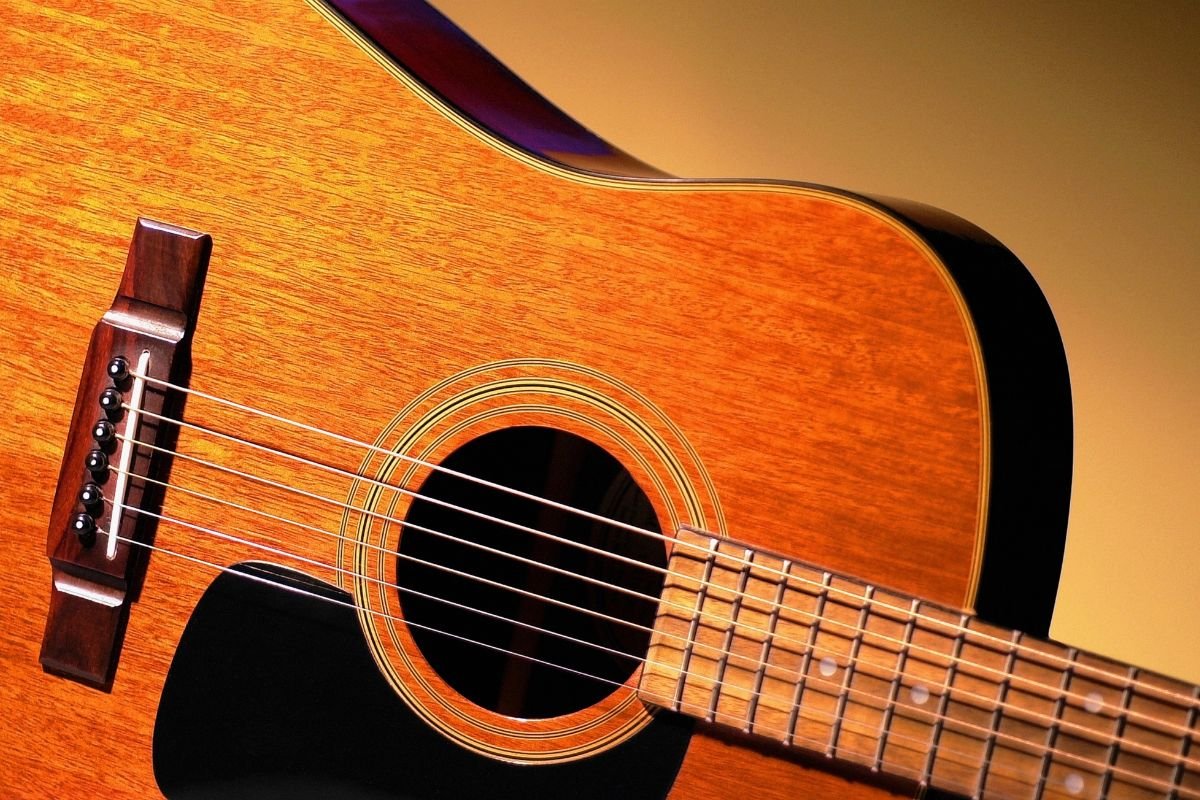
The foundation of an acoustic guitar’s sound is laid by the tonewoods used for its body’s top, sides, and back. The type of wood will determine how loud or soft a guitar may sound as different types of wood have differing levels of stiffness and density.
When it comes to guitars, there are two types of tonewood:
- Softwood
- Hardwood
Softwood guitars tend to be lighter with a high tensile strength. Examples include spruce, cedar, and redwood.
They provide the perfect combination of strength, elasticity, and lightness. Therefore, this type of tonewood is ideal for a guitar’s soundboard and top.
Hardwood is generally stiffer and denser. A common type of wood used in the construction of acoustic guitars is mahogany. This is typically used for the sides and back of the guitar.
This type of wood is typically durable, somewhat economical (cheaper than rosewood), easy to work with, and attractive. It is also resonant, affecting the overall sound quality of a guitar.
Let’s take a look at some of the most popular and commonly used tonewoods in the construction of acoustic guitars and compare their tonal qualities, frequency range, and more below.
Rosewood
A type of hardwood, the frequency range of rosewood tends to be on the low-end to medium scale. It generally has a richer, more musical tone that helps achieve more complexity and sustain in a guitar’s sound, as well as ringing overtones.
Rosewood has a wide frequency range with highs that are similar to the ringing of bells, but also deep lows. For players who prefer a richer acoustic guitar sound, powerful treble and bass, and a great deal of sustain, rosewood is a good choice.
It is no surprise it is one of the most used types of wood for acoustic guitars.
Mahogany
Another type of hardwood, mahogany helps produce punchier, more woody sounds.
An acoustic guitar tends to have a dryer sound with fewer ringing overtones when made with mahogany and it will often be the best option for more aggressive players as it offers a more controlled response.
Its tone is often clear and loud with a greater focus on midrange frequency. Mahogany guitars are ideal for those looking for clearer tones and beginners.
Sapele
Sapele is a type of hardwood and often used as an alternative to mahogany. It typically has a mid-range frequency, providing a consistent, balanced tonal output.
Sapele is suitable for an array of playing styles but is a great option for those who are on the lookout for a versatile acoustic guitar that offers superb clarity and all-round balance.
Maple
Maple, a type of hardwood, typically offers a more medium to high-range frequency. Its response is generally more linear and allows a guitar player’s style and technique to shine through.
Maple guitars are often clear bright with a focused tone and are suitable for players who play with a quick attack and perform fast notes. Overall, though, maple responds well to many guitar playing styles.
Blackwood
Blackwood is yet again a type of hardwood, typically boasting a mid-range frequency. Blackwood guitars usually have powerful volumes and tonal outputs.
Although their tones are typically dry and clear, they still provide a warm sound with a richness similar to rosewood. Blackwood is suitable for all types of guitar body shapes and playing styles.
Ebony
Providing a mid-range frequency most of the time, ebony is a hardwood that is perfect for those looking for clear notes and strong projection from the guitar’s volume.
This type of wood has rich overtones that react well to both heavy attacks and lighter playing touches. Fingerstyle players who prefer ringing overtones that are sustained often go for ebony.
Koa
Our final example of back and side guitar hardwood, koa offers a medium to high-range frequency. This wood is very popular thanks to its exotic, tropical hardwood appearance.
Its tonal properties are similar to that of mahogany but it’s the age of koa that can affect how the guitar sounds. The older koa is, the warmer and sweeter the guitar will generally sound.
If a guitar’s aesthetic is key, those made with koa always look beautiful. These guitars are also ideal for players looking for some additional top-end vibration.
Redwood
Redwood is a type of hardwood but rather than being used for the back and sides of an acoustic guitar, it is used for the top. It generally has a dynamic frequency range and provides a guitar with powerful volume and a bold response.
These guitars usually have warm overtones and a top-quality high end. Looking for a great overall response and a guitar that is attractive? Redwood models may be the answer.
Sitka Spruce
Also used for top wood, sitka spruce is a type of softwood with a dynamic frequency range. This wood is most commonly used for guitar tops due to its stiffness and lightweight nature.
Therefore, the top has more freedom of movement resulting in a clearer, more vibrant tone.
Sitka spruce guitars are often preferred by players who are looking for something more versatile and those who finger pick lightly or strum aggressively.
Red Cedar
A type of softwood, red cedar offers a dynamic frequency range but is less dense than spruce. Used as a top wood on acoustic guitars, red cedar often provides a warmer guitar tone thanks to its softness.
This wood is also better suited to nylon strings thanks to their supreme responsiveness. For light finger pickers or light to moderate strummers, red cedar guitars are a great choice.
Fretboard Wood
Fretboard tonewood usually comes in the form of ebony. This is due to its high density but some manufacturers also use rosewood for the fretboards. However, because rosewood has a lower density, it is not as strong or robust as ebony so may not last as long.
Some cheaper acoustic guitars come with fretboards made from Richlite, which is a complex material. Again, though, this tends to have a weaker strength compared to ebony and will not last as long, hence its cheaper price tag.
Sizing An Acoustic Guitar
As we have seen above, acoustic guitars come in a wide range of sizes and designs. It is important to try out different guitar models to find what is right for you. Although you may love the look of one, it may not feel comfortable to play.
Here are a few factors to look at when choosing the correct size acoustic guitar.
Guitar Body
There is a guitar size to suit everyone, whether it be large, curvy, or compact. When choosing a new acoustic guitar, consider how its shape gels with you and your body as you hold and play it.
Firstly, you need to think about whether you will be playing the guitar in a sitting or standing position mostly. Many acoustic guitarists play sitting down, especially beginners. But, the body shape of a guitar can influence how comfortable it feels.
The taper of its waist and other contours of the body can have a say on how high the guitar sits on a guitarist’s lap. So, a guitar with a wider waist will tend to sit higher on you when sitting down.
To choose the right acoustic guitar for you, you must try it out first. When playing, consider how you feel as you pick or strum the guitar when your arm is draped over its body.
If you plan to play sitting down most of the time, a curvy bottomed large acoustic guitar can force your strumming hand higher, leading to an uncomfortable playing position. If this is the case, playing freely will become more challenging.
Moreover, the contours of some guitar shapes can interfere with a woman’s body shape and curves. If you find this is the case when playing guitar, a smaller bodied model is the best option.
Guitar Neck
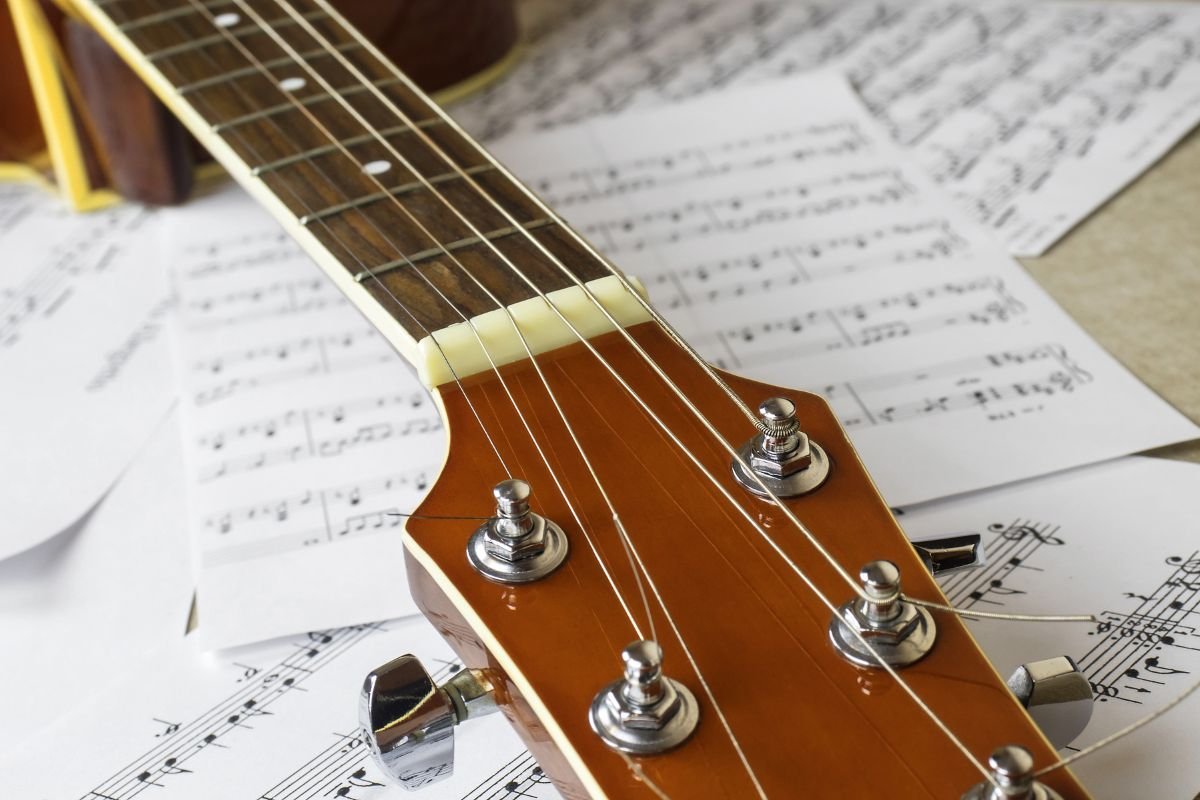
The structure of a guitar’s neck is critical in how comfortable you feel whilst playing it. If the neck of a guitar is comfortable, the whole playing experience is easier.
Therefore, playing chords and notes will be more enjoyable and easier to learn. If you’re uncomfortable, you will soon feel fatigued, especially if playing for long periods of time.
Remember, your hand size will differ from other players, so a neck that is comfortable for them may be uncomfortable for you.
You need to consider a few features of a guitar neck, such as:
- It width
- Its profile
- Its action
- Its scale length
- Its intonation
The width of an acoustic guitar neck is usually measured at its nut (this is where the neck joins the guitar’s headstock). The wider the neck, the greater distance there will be between guitar strings.
Wide necks tend to measure from at least 1-7/8 inches. These are best suited to players with larger hands or longer fingers.
A medium-sized neck typically measures around 1-¾ inches. These provide enough space to fret the strings individually with compressed spacing.
The slimmest necks tend to measure from 1-11/16 inches and are easiest to play barre chords on. These are ideal for players with smaller hands and fingers.
The profile of an acoustic guitar is also important to consider. This is the shape of the backside of the neck which sits on a player’s palm whilst playing the guitar. Guitars come with different profiles.
Some have broader profiles, whereas others are narrower. The former are the easiest to play and best for beginners.
The action of an acoustic guitar is key to choosing what is best for you. The action is the height of the strings from the fretboard. The most convenient guitars to fret are those with lower actions, but if the action is too low, the strings can vibrate.
But, if the action is too high, you’ll need to apply more force and pressure to the strings to achieve a desired sound. This will soon lead to fatigue.
The length of the guitar’s strings from the nut to the saddle is known as its scale length. This can affect the string tension and result in an uneven tone.
When trying out different acoustic guitars, you will find that the scale lengths can differ wildly. This is because manufacturers tend to define their own scale lengths.
For guitar players with shorter, smaller hands, short-scale guitars are considered the best choice as they come with a reduced string tension. Therefore, it is easier to perform more notes with fewer fingers.
The intonation of a guitar is vital in how it sounds. When an acoustic guitar is properly intonated, its open strings and all fretted notes will sound perfect.
This equates to a guitar that is perfectly in tune up and down the entire fretboard resulting in a more uniformed, pleasant sound.
Acoustic-Electric Guitars
Many acoustic guitars are hybrids these days. By that, we mean that they can also be plugged in and played through amplifiers for louder volumes.
This is thanks to onboard electronics and pick up systems built into the guitar’s body. If you intend to play your guitar live, such as gigging, this is a feature you should be looking for.
Referred to as electric-acoustic guitars, these commonly have a guitar pickup system consisting of a piezo pickup.
This utilizes crystals to transfer the sound of the strings and the vibration from the resonance of the wood into an electronic signal. These guitars also have a preamp that helps make this electronic signal stronger.
Some guitars are made with other types of pickups, such as Taylor Expression System 2 pickups. Rather than using crystals, these use a combination of sensors and an internal mic to provide a more natural, less electronic tone.
The preamp on an electric-acoustic guitar typically provides the guitarist with the ability to control the guitar’s volume, treble, bass, and even tune the guitar via an in-built tuner.
You need to consider what features you would need on your acoustic guitar and whether an electric-acoustic is required. In most cases, these will be more extensive than a standard acoustic guitar.
Best Acoustic Guitars On The Market Right Now
We scoured the market and found the best three acoustic guitars currently on the market. After testing out each instrument and considering their features, the following three acoustic guitars are top quality choices for any level guitarist.
Epiphone DR-100
Made by a world renowned brand, this Epiphone DR-100 acoustic guitar is an excellent entry-level instrument but feels like something more expensive and prestigious. With a very affordable price tag, this guitar is top quality.
With an all-laminate construction, this full-bodied guitar sounds fantastic and boasts a powerful voice due to its dreadnought shape. Whether you perform flat-picking or prefer fingerstyle, this guitar offers a superb dynamic range.
It offers solid tones and its build quality is excellent. A good guitar to start you on your musical journey.
Martin LX1E Little Martin
Most experienced acoustic guitarists will agree that Martin guitars are some of the best around. This Martin LX1E is a great example of what is best about this brand. A small-sized dreadnought, this is perfect for traveling around with.
It even comes with a gig bag to keep all of your accessories in, too.
Although a compact guitar, its volume is not. Compared to many small-bodied guitars, this LX1E boasts much louder acoustics. It offers a little low-end frequency but it shines best in terms of mid and high frequencies.
It is made with Fishman Sonitone electronics which means you can plug it in to a PA or amplifier and gig with easily. And, the controls are hidden inside the sound hole so the guitar’s exterior is kept looking clean and organized.
When plugged in, the Martin LX1E has a beautiful tone, making it ideal for any gigging guitarist.
Taylor GS Mini
Like Martin guitars, Taylors are revered by acoustic guitarists worldwide. The Taylor GS Mini has been a hit with guitar players since it was introduced in 2011 and has helped bridge the gap between workhorse, gigging guitars and travel models.
Essentially, this mini guitar is a smaller version of the more popular (and more expensive) Taylor Grand Symphony-shaped acoustic guitar. Its size makes it much easier for smaller hands to play on and beginner guitarists.
And, thanks to its small stature, it is perfect for leaving around the house and picking up when in the mood. It has a shorter scale but its string placement is the same as a regal-sized guitar. Therefore, it is great for fingerpicking.
As for tone, the Taylor GS Mini guitar is very bright and clear, like most Taylor models. Although its volume is not the loudest or most powerful when unplugged, its built-in ES-B acoustic guitar pickup more than makes up for that when plugged into an amp.
When played and plugged in, this acoustic guitar competes with many full-sized contemporaries.
In Summary
Today, we wanted to set out a guide to help you find the best acoustic guitar for you and your needs. By now, we hope you have a better understanding of what to look for in your next or first acoustic guitar.
Above are the most important factors and features to consider when browsing acoustic guitars and, although we have also included our top three acoustic guitars on the market right now, there are so many more for you to choose from.
The best acoustic guitar for you depends on various factors, such as how often you want to play it, whether you will be gigging with it, and your guitar playing style.
Take your time when choosing a new acoustic guitar and play different sizes, shapes, and models before deciding on one. Most of the time, you will have a gut feeling that one is right for you. If you feel like it is the one for you, go for it.
Thanks for reading and we hope you find your new acoustic guitar very soon!
